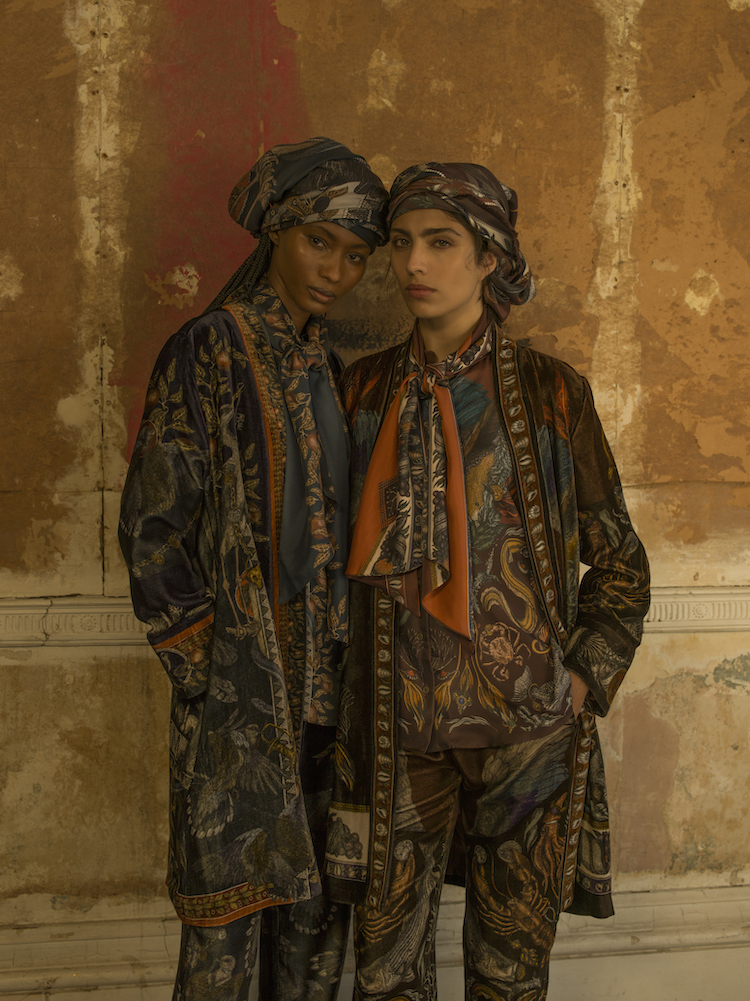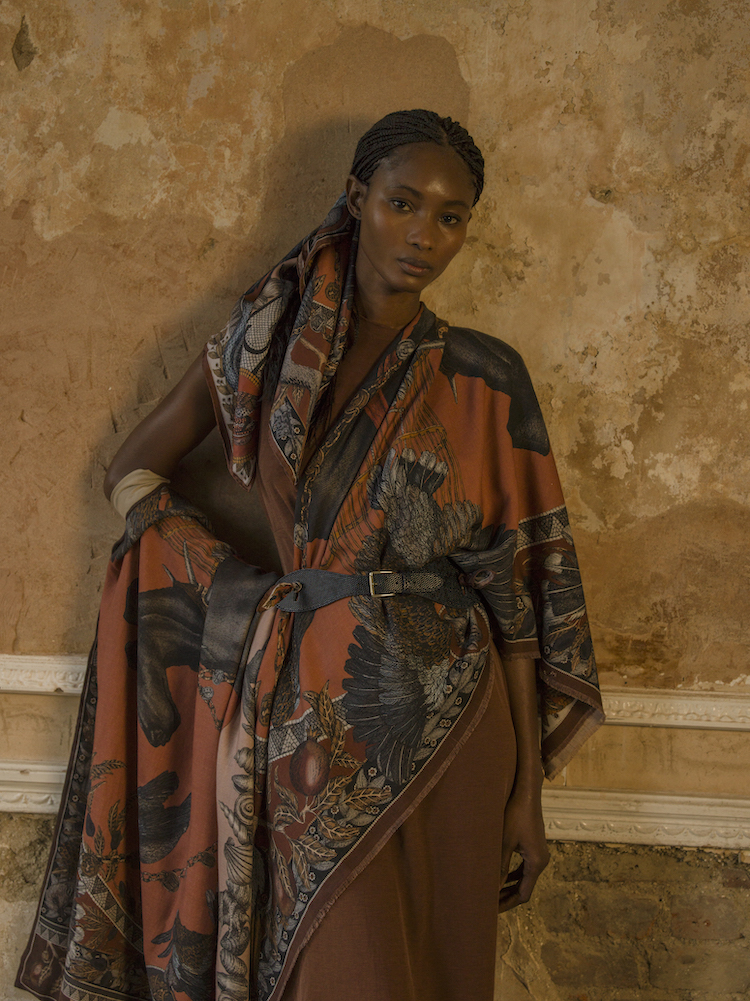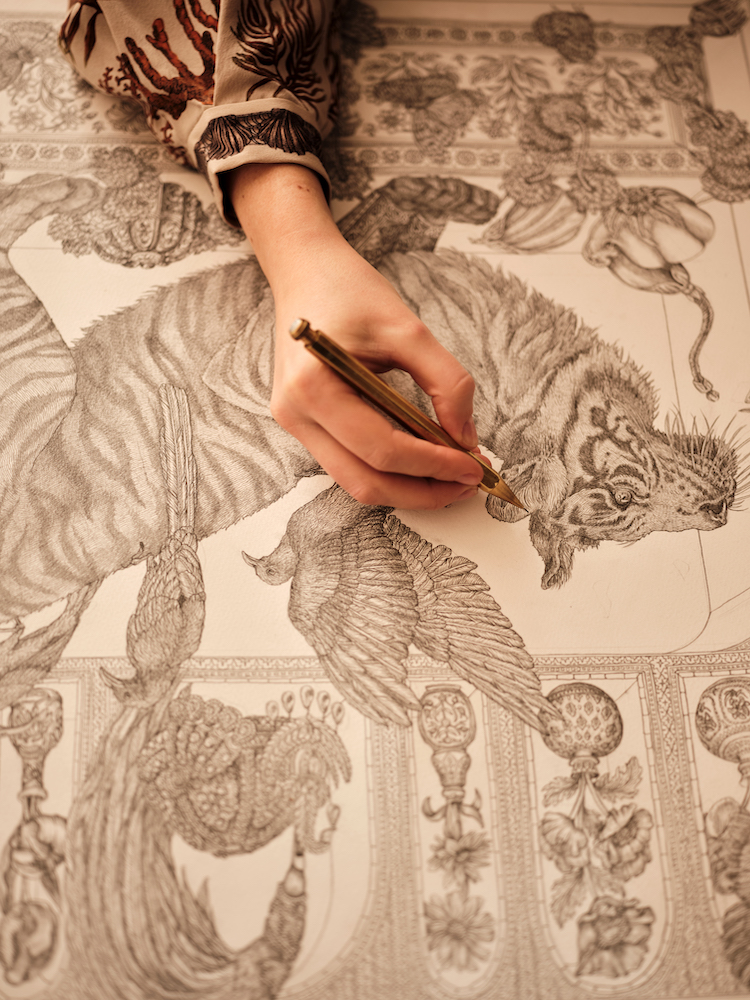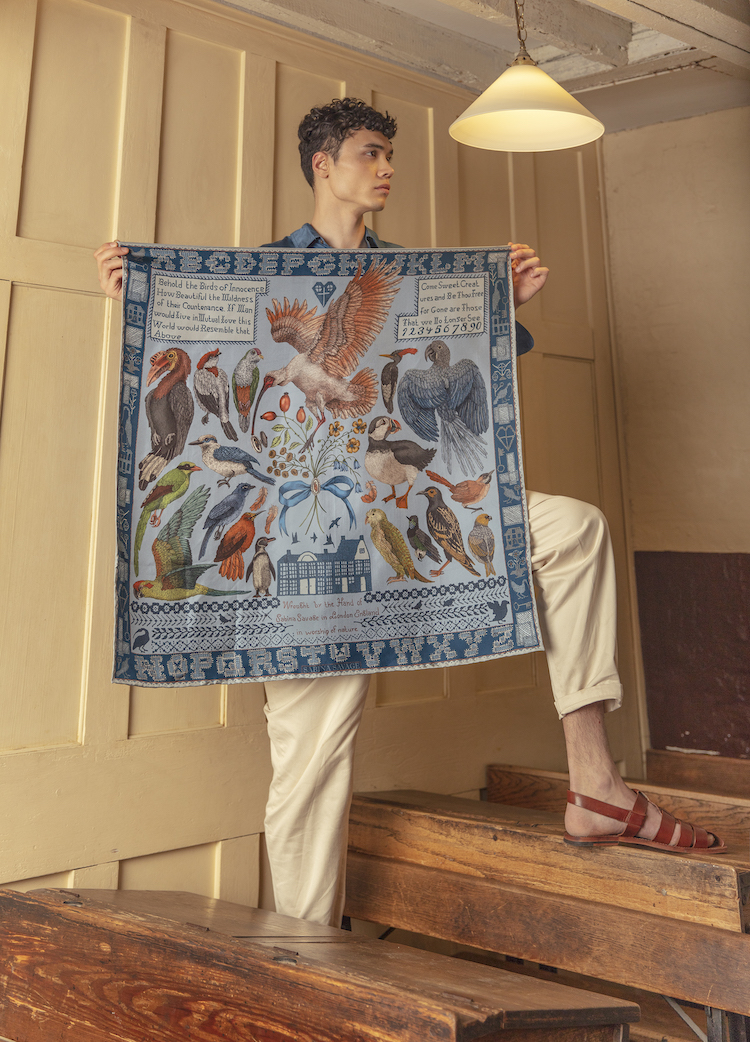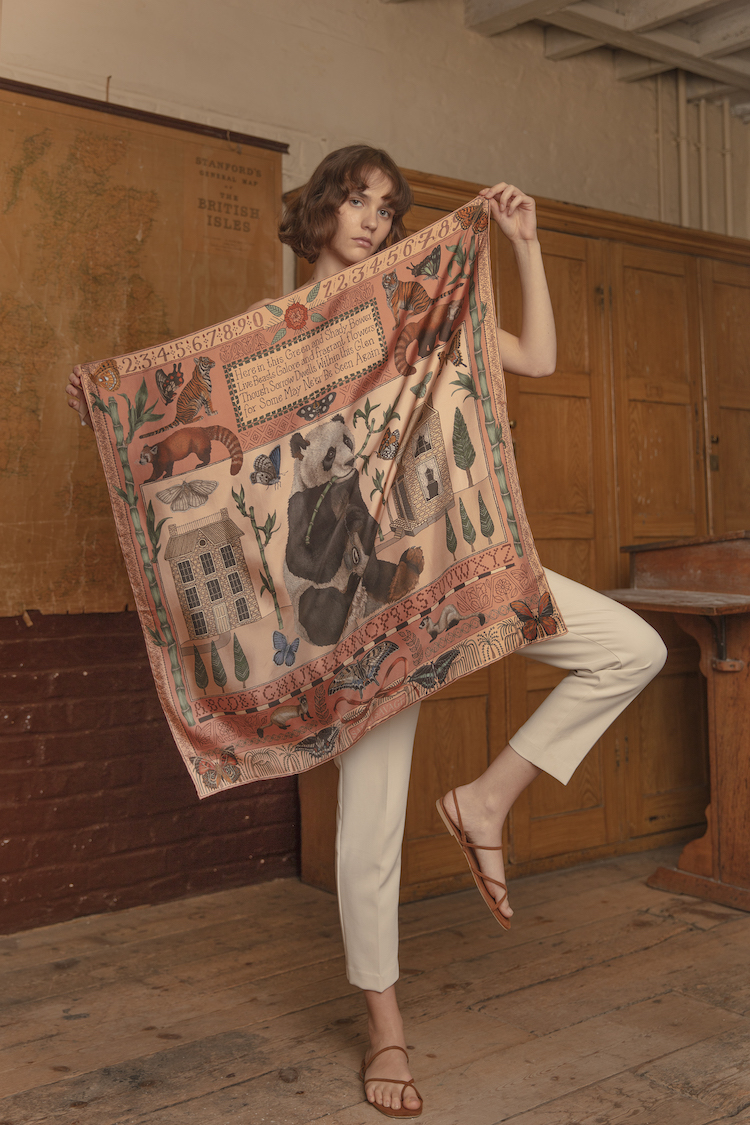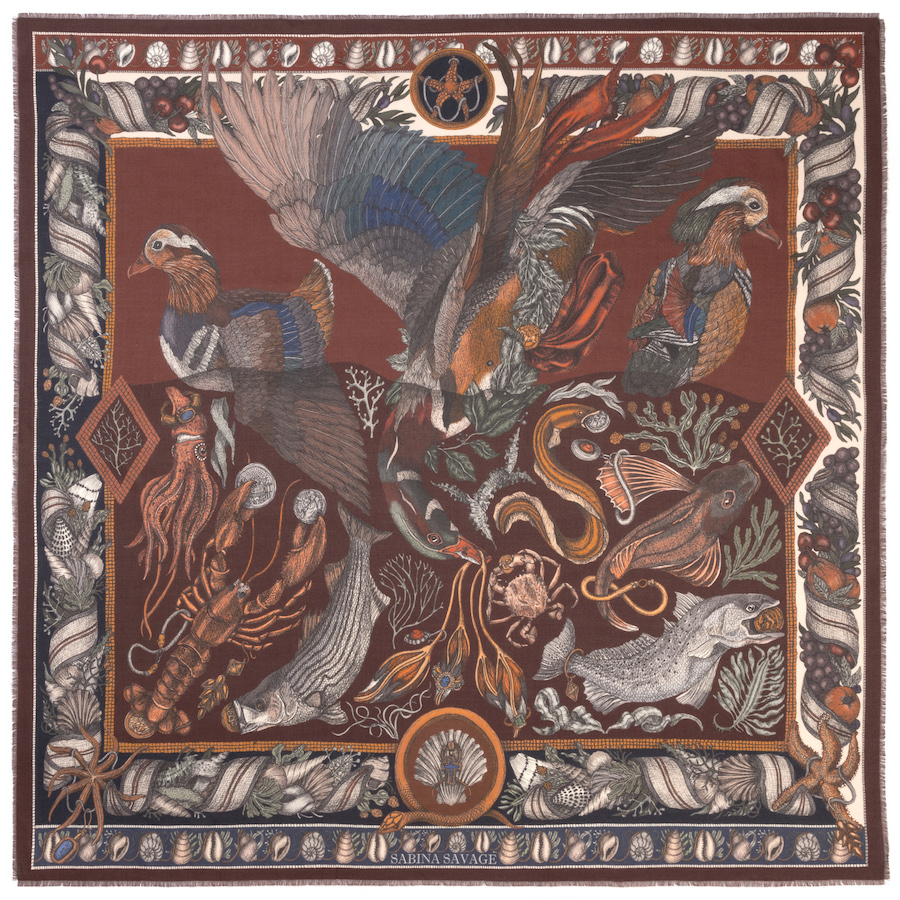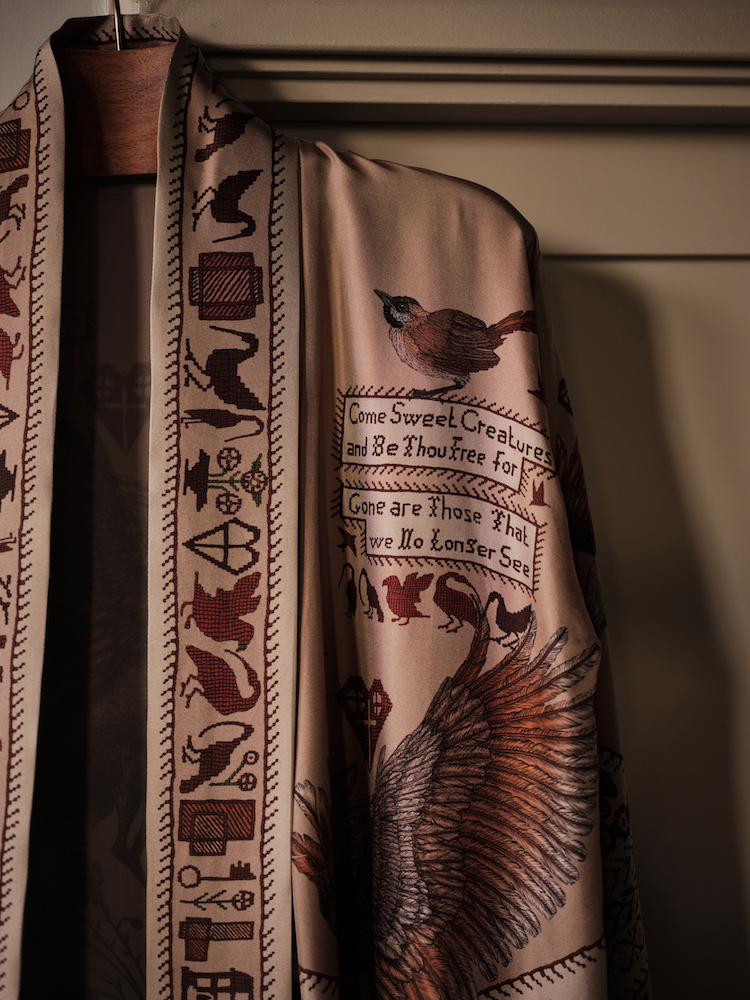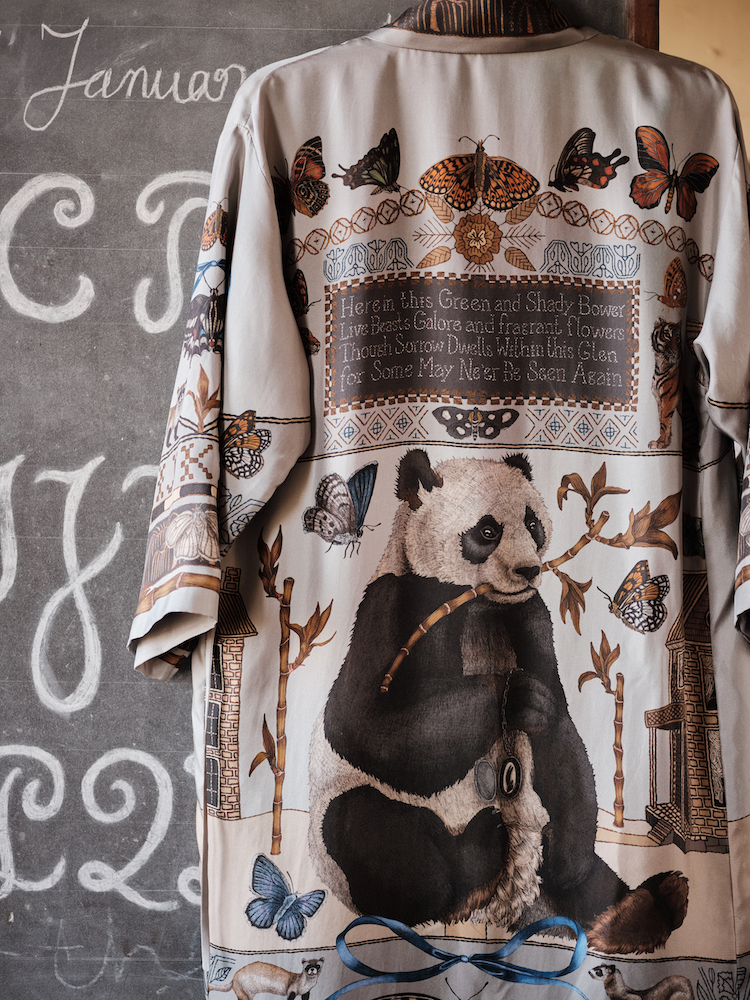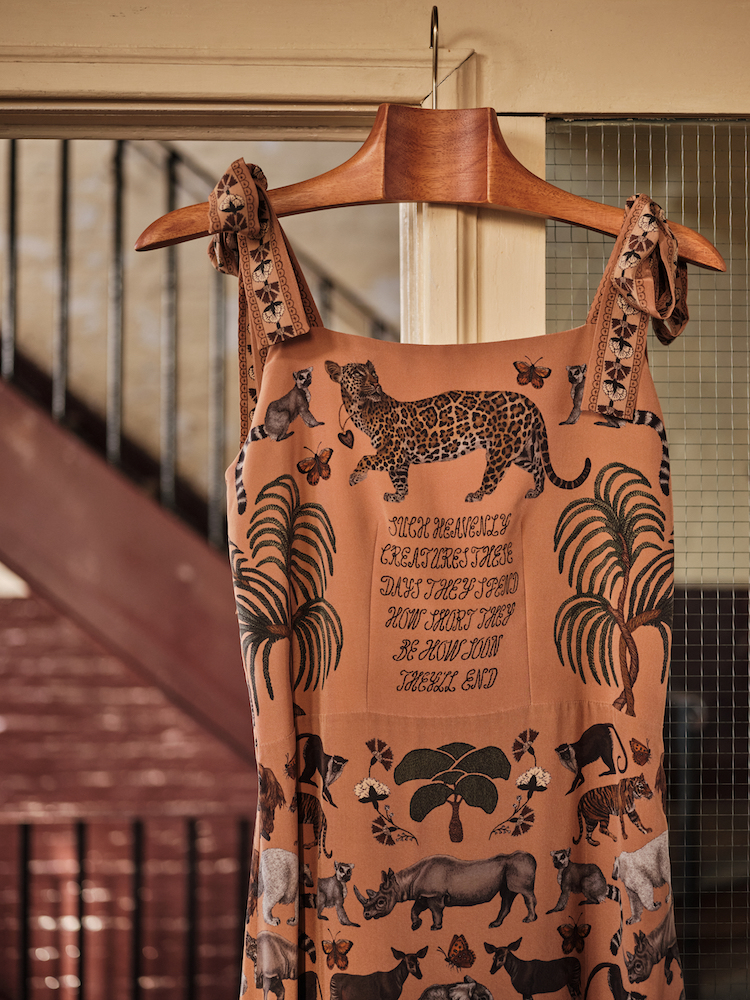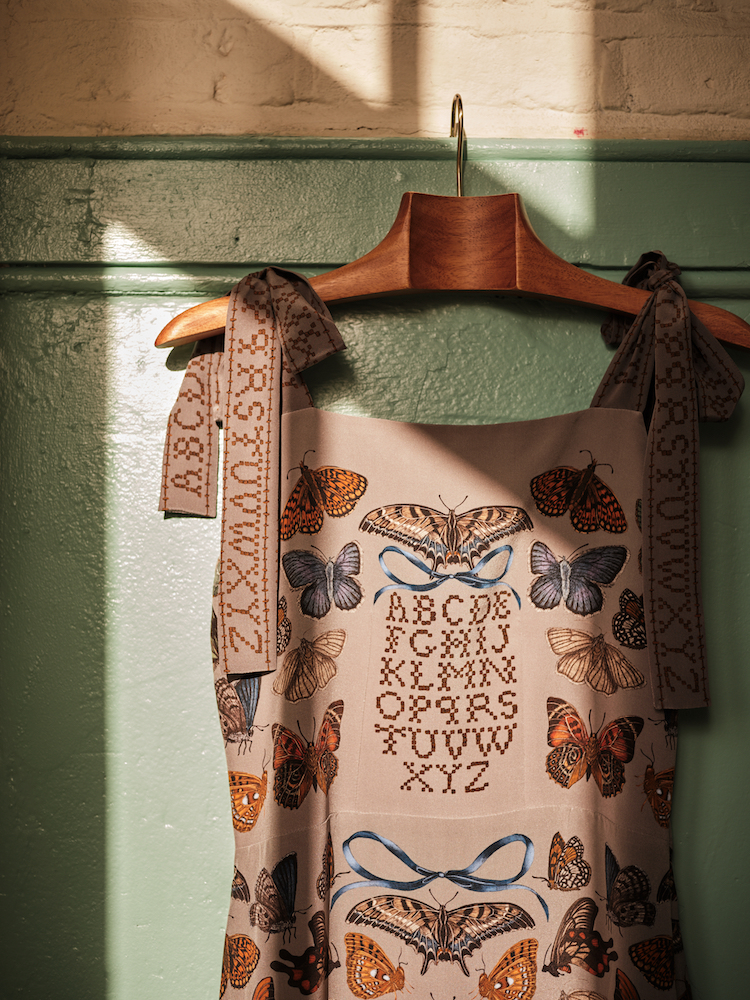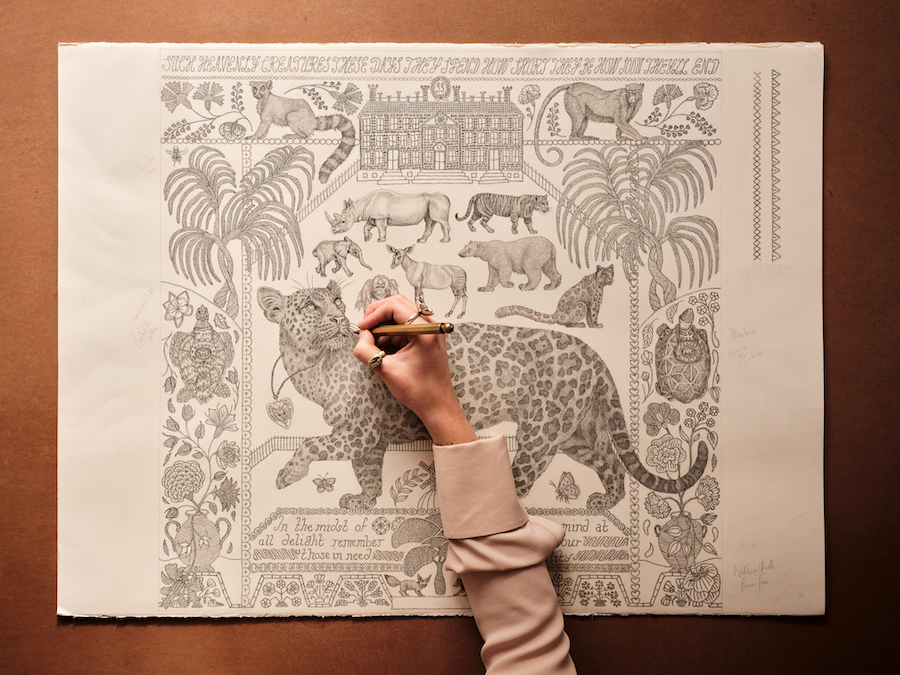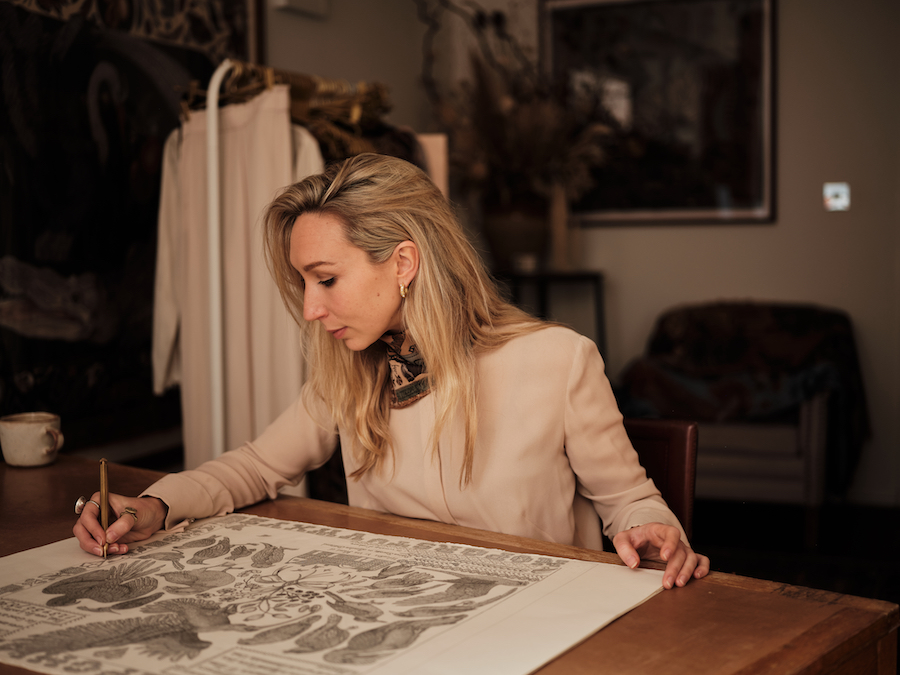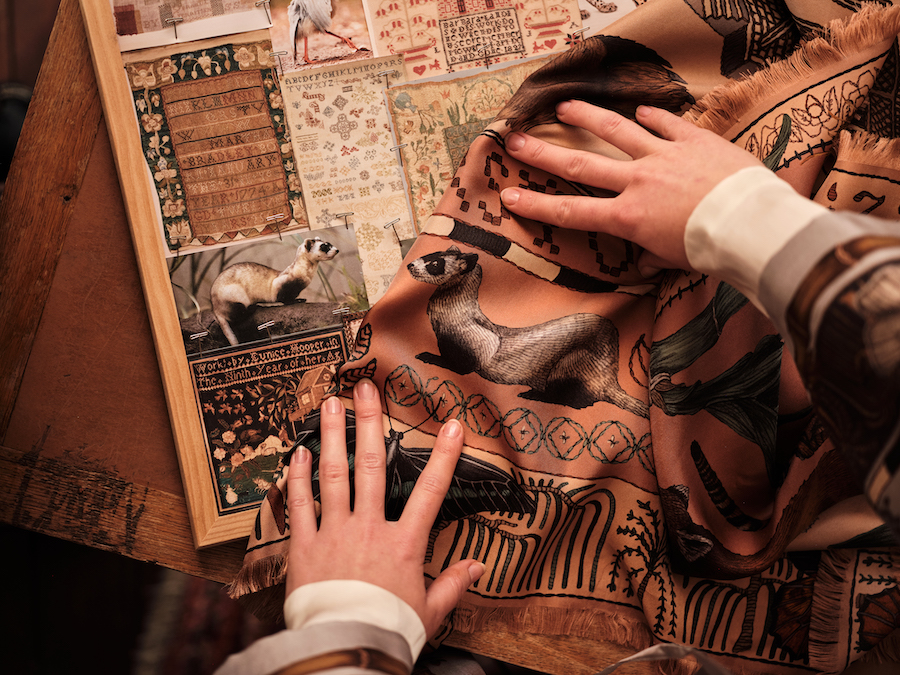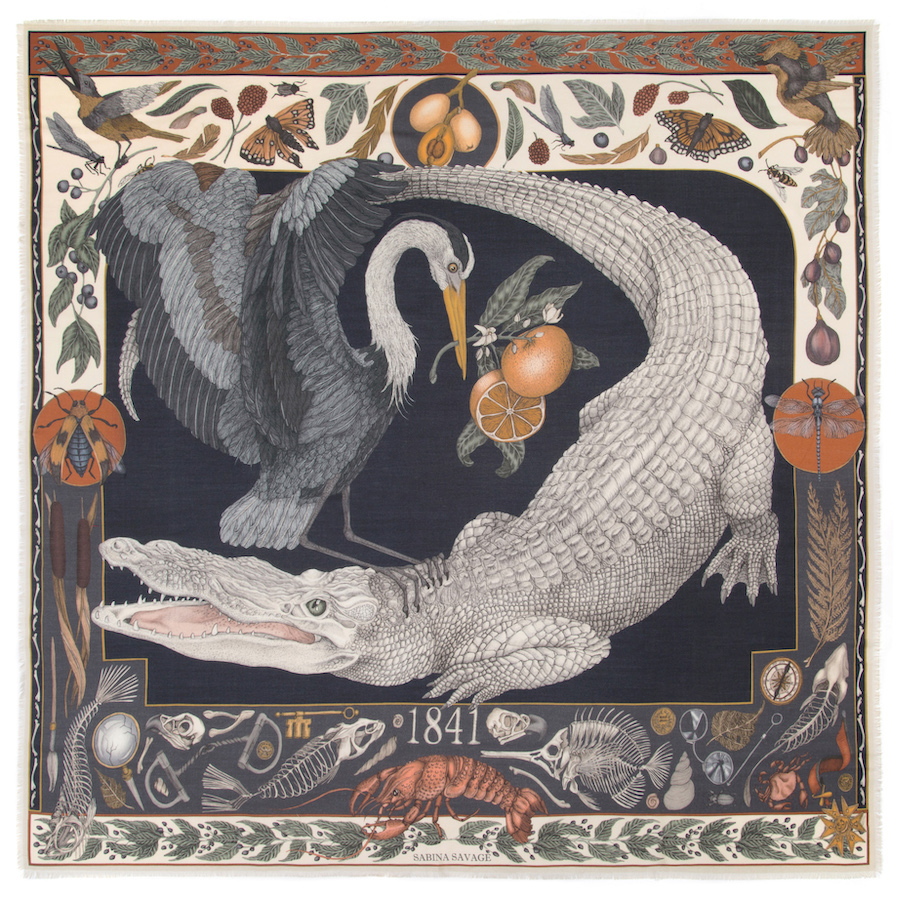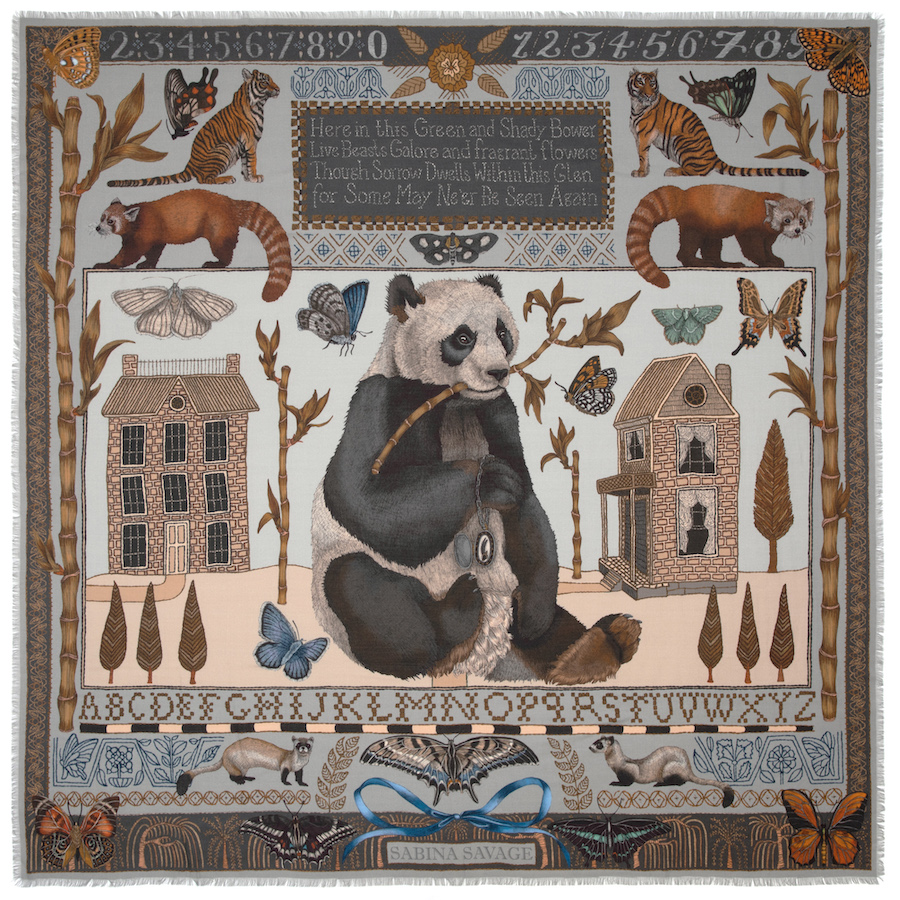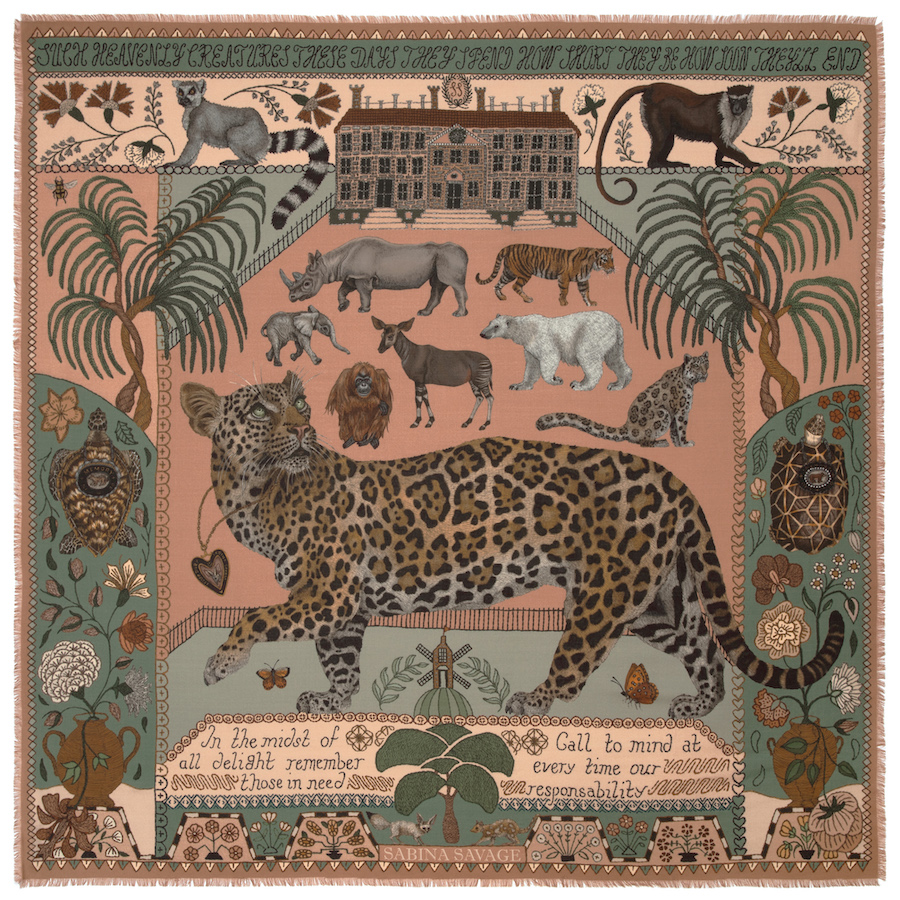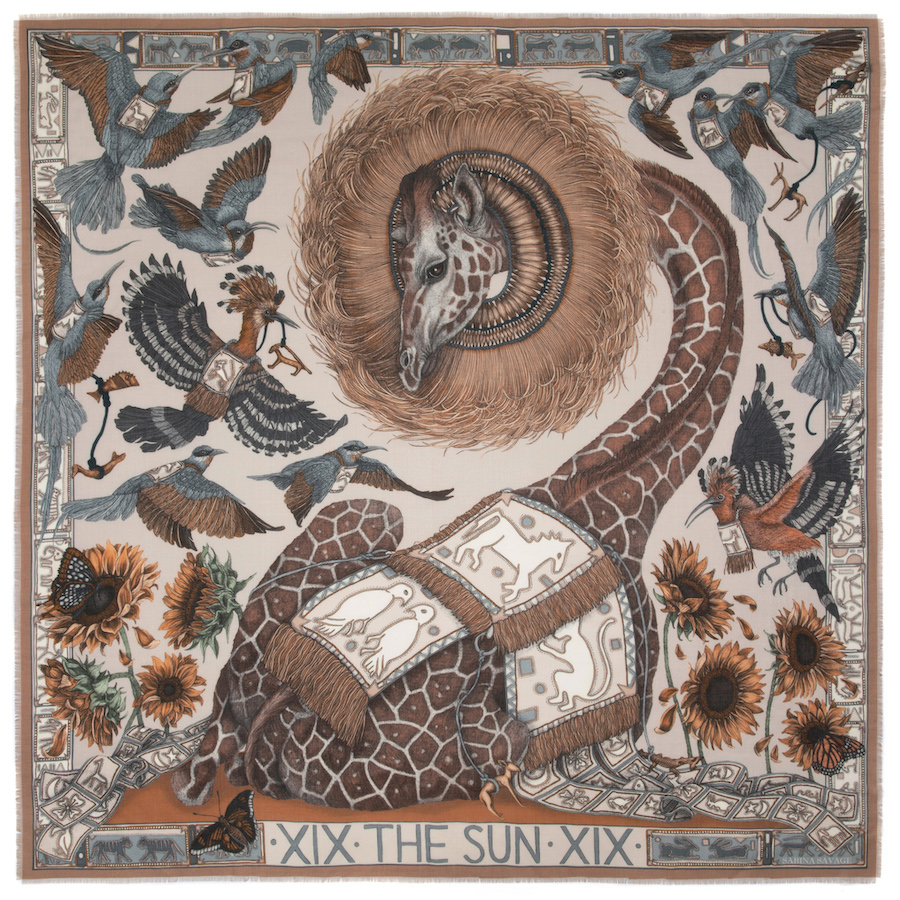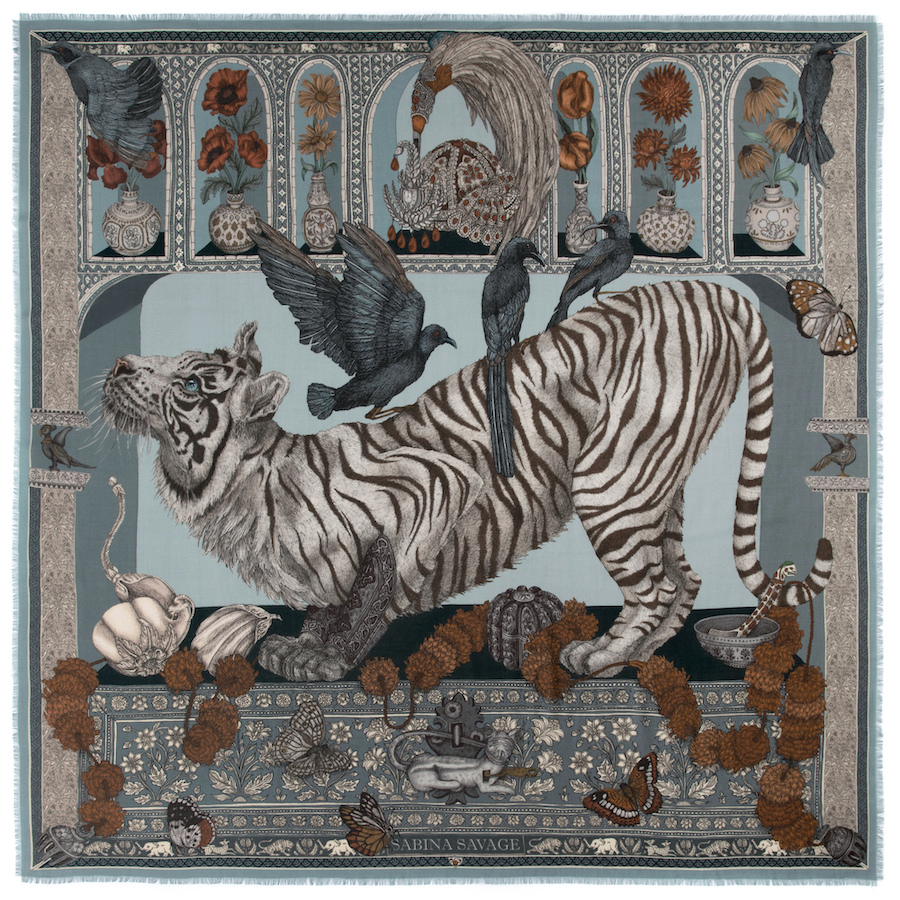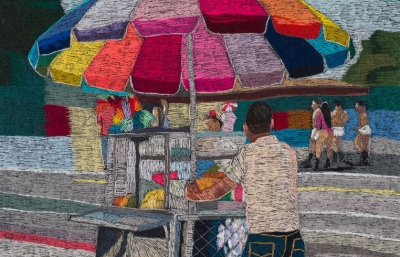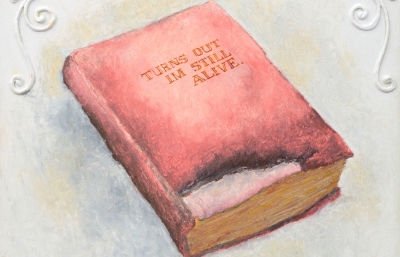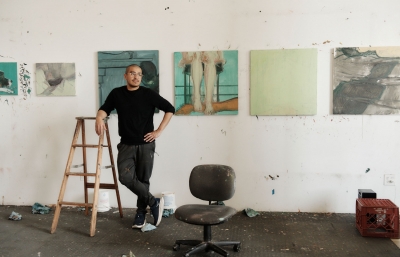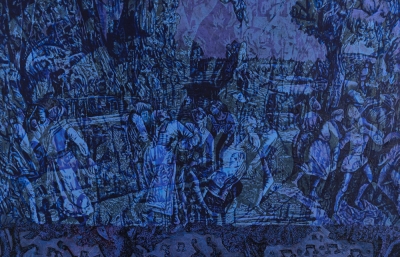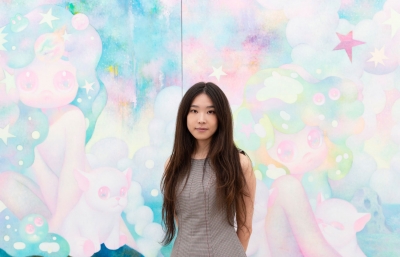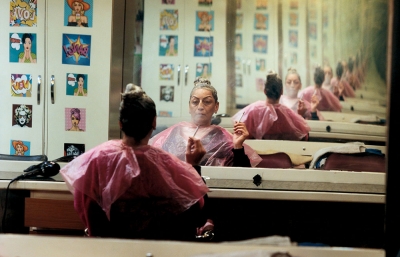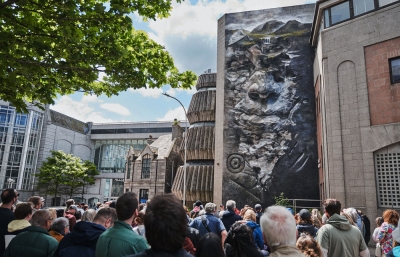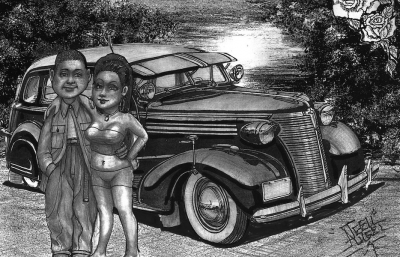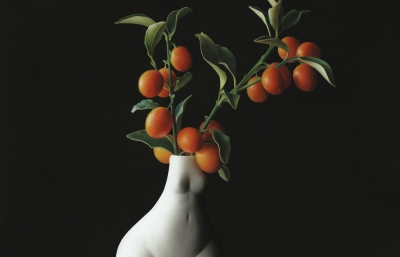Diving into a favorite painting is a pleasure, picturing the story within is an adventure. Sabina Savage creates art that is truly immersive, fashioning pieces that place silky, colorful objects in your hands, an invitation to fold, loop, and, drape those fantasies, as well as revisit them!
Gwynned Vitello: I imagine you wandering forests, talking to foxes, and waiting for owls to visit at bedtime when you were a kid.
Sabina Savage: That’s close to the truth. I grew up in the English countryside in an old farmhouse away from any towns. My parents are also animal lovers, so I had a very naturalistic upbringing—dogs, cats, horses, chickens, and the occasional sheep. I remember my parents rescuing a jackdaw with an injured wing. We it named Jack! We’d put on an old glove and he’d fly around the garden and land on our hands. Once back into the wild, he’d follow us along the lanes. There is a small copse of woodland behind my parents where my sister and I spent hours following trails to see where foxes and badgers made their homes.
Did you enjoy fairy tales like the Brothers Grimm? There’s both a feral and tender mood in your work.
I’ve always loved macabre fairy tales like the Brothers Grimm. When I was older, I moved on to Angela Carter whose book of short stories, The Bloody Chamber, is based on folk and fairy tales, but she extracts often unsettling themes, adding a feminine, gothic edge. Recently I’ve become enthralled with Shirley Jackson and am working my way through her works, also gothic and unsettling.
After high school, you were intent on studying fashion, but you’re a supremely talented drawer.
I sketched as a child, and I remember a drawing book that focused on how to draw animals correctly. Each creature was broken down into a series of shapes so you could get the proportions and framework correct before adding detail, a technique I still reference. I also drew things from our garden and the countryside, beautiful seedheads, animal heads, and skeletons, which make wonderful still-life studies. And I drew a lot of fashion illustrations, particularly in my teens.
You chose to study fashion rather than attend an art academy, though a roadblock turned into an opportunity in France, right?
After graduation, I completed a Foundation Course in art and design. It covered all bases in one year, ceramics, oil painting, photography, and art history. It was a wonderfully free year that allowed experimentation in each medium, offering cross-pollination that doesn’t happen in a stricter environment. My heart was set on a particular fashion university in London, but I wasn’t accepted and was crushed. Rather than accept defeat, I changed track and moved to Paris. I studied Couture at a French university and moved two months later. The course was much more intensive than a traditional UK course and focused heavily on the technical side of construction and cutting. A new country, new language, and studying full-time was a baptism by fire, but I’m grateful for the experience.
It’s serendipitous that you interned with Alexander McQueen who tackled couture at the outset and mastered precise design. Like you, he conceived real storylines in his collections.
Lee Alexander McQueen had my entire heart from the start! The creations are some of the most extraordinarily beautiful things ever, and his influence on me can never be underestimated. The collections had such theater and genuine magic, crossing art and sculpture as firmly as apparel. An artist with incredible technical skill, his chosen canvas was the human form. Almost all the techniques and knowledge I use were gained from working at fashion houses. I’d never worked with prints until McQueen, and hadn’t really drawn since I was a child. Being part of a larger team also meant gleaning insight from many skill sets, from dealing with suppliers to production to shipping dress samples.
What made you decide to venture out on your own, and why scarves?
I always wanted to start my own brand, but the finances required were beyond my means. After McQueen, and loving my newfound experience in print design, scarves seemed like a good entry. Production would be manageable with no sizing to consider. Honestly, I began my first collection as a hobby so I could continue learning and growing.
My first collection was a series of pencil studies of birds with no real narrative and uncolored designs. Previously, I needed to adapt my handiwork to different collection themes and styles; this was about finding my personal drawing style as an illustrator and working out layouts and compositions that would work for scarves. I had no concept of a business plan, but this helped me learn about production and the challenges ahead. Narrative followed later. I worked from my childhood bedroom and printed just a few meters of fabric and hand-edged the scarves myself.
What’s involved in the process? Does completion actually take longer now that you know what makes the perfect piece?
The process evolves, each collection taking ten times longer than the first. Once I have my narrative, each drawing takes four to six weeks. I’ll have a basic composition idea, but actual design work happens in real time—no shortcuts! Details are key to telling my stories correctly, so I draw the scarf exactly as it will appear on fabric. I usually listen to audiobooks on the subject while I draw, thinking about how the piece will be worn, that corners have interesting details, as well as color and pattern, however the scarf is worn. Once the pencil stage is complete, drawings are scanned and I color them by hand digitally, using a large Wacom screen and pen so there are multiple colorways.
How do you choose fabrics to present your art?
My first collection was a wool/silk blend, still our most popular fabric. It offers a beautiful matte finish with a soft drape. I only work with natural fibers, printing on wool, silk, and cashmere, and printing the same designs across multiple fabrics. It’s amazing how differently the colors and prints adapt to each base. Silk twill has a lustrous shine and adds real vibrancy. In contrast, the dusky surface and fine weave of cashmere softens and mellows each print into something subtle and ethereal.
How do you choose a particular composition and where to place it?
Composition, colors, details, and characters are dictated by research into my subject. When customers purchase from our website, they receive a storybook showing the mood board followed by the original illustrations. In The Treasures of Pompei, for example, compositions, colors, and subject were inspired by mosaics uncovered during excavation of the city. Combined with my invented narrative, I add details and clues to tell my story, always aware of the finished details to ensure each beautiful element shows however the scarf is worn.
Let’s go more deeply into your preparations. I imagine you pouring over medieval manuscripts, in addition to wandering through forests.
My initial challenge each season is to develop my new tale. I collect inspiration and make notes, hoping to spark a new idea at the right time. I visit a lot of museums and galleries when it’s time to get started. I delve deeply, reading and making copious, hand-written notes. A physical mood board sits above my desk with my detailed research close at hand while I draw. I wasn’t well-traveled until recently, and I wish I had the time now, so exploration is still through my work. With this knowledge and experience, it is increasingly important to ensure my work is respectful of the histories and cultures I reference.
Describe the process of transferring the drawing to the fabric.
Once illustrations are complete and colored they’re sent to our UK printers to be digitally printed. My illustrations would not be suitable for screen printing due to the gradients and fine details within the pencil line; digital print is far more environmentally friendly. Often, there are several test runs (strikes) to be sure colors print perfectly. Once fabric panels are printed, the scarves are precisely hand-rolled or hand-fringed by a team of UK artisans.
Although a scarf can be worn as a pareo, sarong, or bandeau, you also offer a range of wearable clothing.
The clothing line has long been a dream. In previous roles, I loved working on placement prints, where each detail sits on a specified place on the garment. The print can be engineered around the body, as in a butterfly cuff or border snaking the hemline, a challenging method to expand my illustrations and play with composition. I go to great lengths in creating technical packs for the workshop, showing where each piece must be cut and where the print on each seam should join. Each panel is hand-cut and assembled individually, so production is meticulous. 
What have you learned from studying animals, and is there a message about them in your work?
Coming from my nature-oriented household, I’ve always felt a close relationship with animals. Anyone following me on Instagram knows how close I am to my little dog Gin (a street dog rescued from Cyprus) and my cat Panther (found at the end of my garden at two weeks old). An animal’s soul is as complete and complex as ours; it’s difficult to contemplate the suffering and destruction humans inflict on their world. I don’t embrace cutesy images of animals, though, and fully embrace the wild side of nature, which I believe comes out in my work. A customer noted that a majority of my narratives involve protagonist animals escaping from human constraint, an unconscious message that’s now a very conscious one.
Do you have a secret for those of us who love scarves, but are all hot-dog fingers?
I recommend a visit to our YouTube channel where I can demonstrate knots and fabrics at all levels of complexity. You’ll even spot my dog, Little Gin demonstrating her finest styles too!
SabinaSavage.com // This interview was originally published in the Summer 2023 Quarterly

